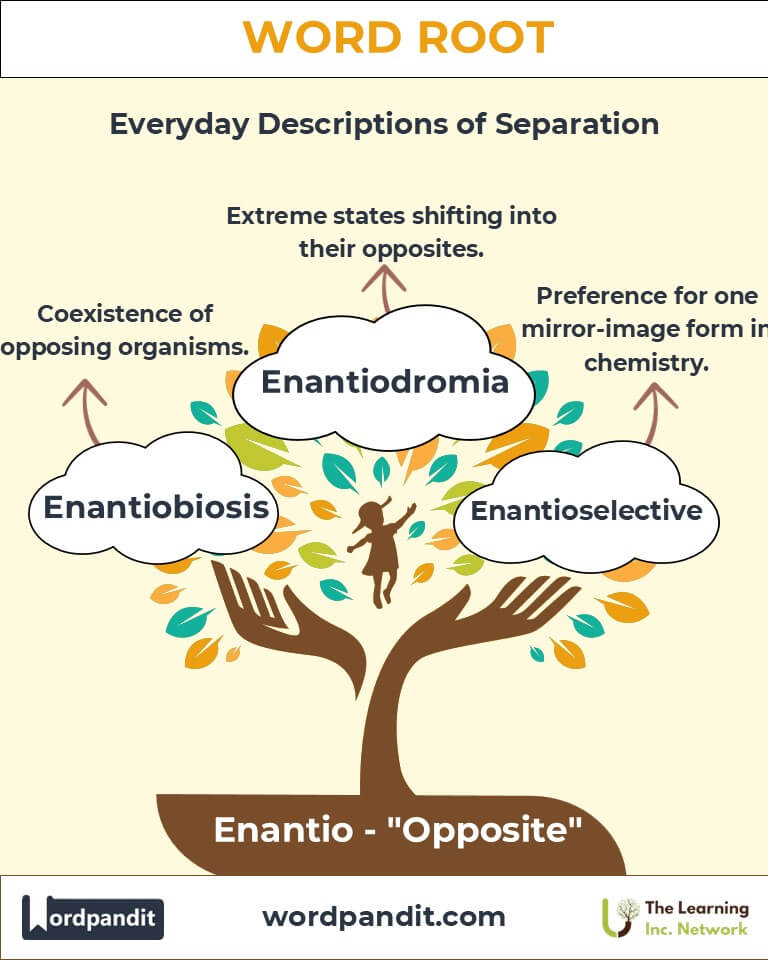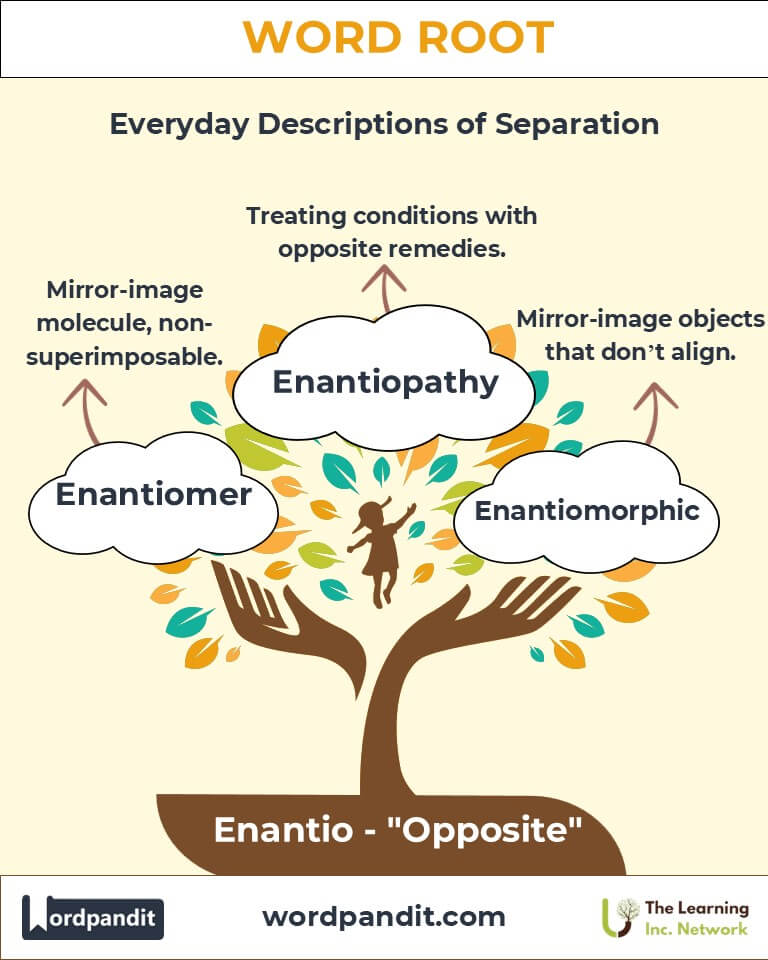Enantio: The Root of Opposites in Science and Philosophy
Discover how the Greek root "enantio," meaning "opposite," forms the backbone of terms describing contrast and duality in science, medicine, and beyond.

Table of Contents
- Introduction: The Power of Opposition
- Etymology and Historical Journey
- Mnemonic: Unlocking the Power of Enantio
- Common Enantio-Related Terms
- Enantio Through Time
- Enantio in Specialized Fields
- Illustrative Story: Enantio in Action
- Cultural Significance of Enantio
- The Enantio Family Tree
- FAQs about the Enantio Root
- Test Your Knowledge: Enantio Mastery Quiz
- Conclusion: The Living Legacy of Enantio
Introduction: The Power of Opposition
Have you ever wondered why certain molecules mirror each other but cannot overlap? Or why opposing treatments sometimes achieve balance in medicine? These phenomena stem from the Greek root "enantio" (pronounced "ee-nan-tee-oh"), meaning "opposite." Found in scientific and philosophical terms, "enantio" captures the essence of duality—light and shadow, action and reaction, harmony in opposition. From enantioselective chemistry to enantiodromia in philosophy, this root bridges the sciences and humanities, emphasizing the value of contrasts.

Etymology and Historical Journey
The root "enantio" derives from the Greek word enantios (ἐναντίος), meaning "opposite" or "contrary." Its earliest uses were philosophical, appearing in ancient texts to describe opposing forces or ideas. In the 19th century, chemists adopted "enantio" to describe molecular structures with mirrored asymmetry. Over time, the term expanded to encompass medical, psychological, and cultural contexts, highlighting the dynamic interplay of opposites.
Mnemonic: Unlocking the Power of Enantio
To remember "enantio," imagine standing in front of a mirror: the reflection appears identical but reversed. This visual of opposites—same yet different—encapsulates the root’s meaning.
Mnemonic Device: “Enantio is the mirror of opposites—identical yet contrary in every way.”
Common Enantio-Related Terms
- Enantiomer (en-an-tee-oh-mer): A molecule that is a mirror image of another but not superimposable.
- Enantiopathy (en-an-tee-op-uh-thee): A treatment method using opposites, such as hot for cold symptoms.
- Enantiodromia (en-an-tee-oh-droh-mee-uh): A philosophical concept where opposites transform into each other over time.
- Enantiobiosis (en-an-tee-oh-bye-oh-sis): A relationship where opposing organisms coexist.
- Enantiomorphic (en-an-tee-oh-mor-fik): Referring to objects that are mirror images but cannot align.
Enantio Through Time
- Enantiodromia in Ancient Philosophy: Coined by Heraclitus, this term described the natural reversal of extremes, such as day into night.
- Enantiomers in Modern Chemistry: Identified in the 1800s, enantiomers revolutionized drug design.
Enantio in Specialized Fields
- Chemistry: Enantiomeric excess measures the dominance of one enantiomer in a mixture.
- Medicine: Enantiopathy emphasizes balance through opposites.
- Psychology: Enantiodromia explains how suppressed traits can surface dramatically.
- Crystallography: Enantiomorphs describe crystals that mirror but don’t overlap.
Illustrative Story: Enantio in Action
In a bustling pharmaceutical lab, Dr. Maria faced a challenge: designing a drug with minimal side effects. She knew one enantiomer of her compound was therapeutic, while its twin caused drowsiness. By employing enantioselective synthesis, Maria isolated the beneficial form. Meanwhile, her colleague used enantiopathy to treat a patient, applying heat therapy for chronic cold symptoms. Their work highlighted the transformative power of opposites, from molecules to medicine.
Cultural Significance of Enantio
The theme of opposition resonates deeply in human culture. Eastern philosophies emphasize yin and yang, balancing dualities. Western traditions echo this in enantiodromia, portraying transformation through conflict. Even art and literature, from chiaroscuro painting to tragic-comic plays, showcase the interplay of opposites.

The Enantio Family Tree
- Anti-: Antipathy, Antithesis.
- Contr-: Contrast, Contradict.
- Oppos-: Opposite, Opposition.

FAQs About the Enantio Word Root
Q1: What does "enantio" mean?
A1: "Enantio" is derived from the Greek word "enantios," meaning "opposite" or "contrary." It forms the basis of terms describing mirrored structures, philosophical dualities, and contrasting treatments in various fields. For example, enantiomers are molecules that are mirror images of each other but non-superimposable.
Q2: What are enantiomers, and why are they important in science?
A2: Enantiomers are molecules with the same chemical structure but arranged as non-superimposable mirror images, like left and right hands. They are crucial in pharmacology because one enantiomer can be therapeutic, while the other might be inactive or harmful. An example is thalidomide, where one enantiomer treated morning sickness, but the other caused severe birth defects.
Q3: How does enantiodromia relate to psychology?
A3: Enantiodromia, introduced by Carl Jung, refers to the natural tendency of extremes to transform into their opposites. For instance, an overworked person might abruptly shift to seeking leisure or relaxation. It emphasizes balance and the inevitability of change when something reaches an extreme.
Q4: What is enantiopathy, and how does it differ from homeopathy?
A4: Enantiopathy involves treating conditions using opposing remedies, such as applying heat for a cold. This contrasts with homeopathy, which operates on the principle of "like cures like," using substances that mimic the symptoms to stimulate healing.
Q5: What does "enantiomorphic" mean?
A5: "Enantiomorphic" refers to objects that are mirror images of each other but cannot align when superimposed. A simple example is left and right hands. This concept is widely used in crystallography to describe paired crystal structures.
Q6: How is the enantio root relevant in medicine?
A6: The enantio root appears in terms like enantiomer, critical for drug design. Many medications depend on isolating the active enantiomer for desired therapeutic effects while avoiding side effects from the inactive or harmful mirror image.
Q7: How does enantio appear in philosophy?
A7: Philosophically, "enantio" reflects duality and transformation. Ancient thinkers like Heraclitus used it to describe how opposing forces (e.g., day and night) coexist and influence each other, highlighting the dynamic balance in nature.
Test Your Knowledge: Enantio Mastery Quiz
1. What does "enantio" signify?
2. Which term describes mirror-image molecules?
3. What does enantiodromia describe?
4. What field commonly uses enantiopathy?
5. Which term involves mirrored crystal structures?
Conclusion: The Living Legacy of Enantio
The root enantio reminds us of the importance of contrast in understanding our world. Whether in science, medicine, or philosophy, opposites don’t merely clash—they complement, balance, and transform. By exploring "enantio," we appreciate the dynamic interplay of dualities that shape life’s complexity.












